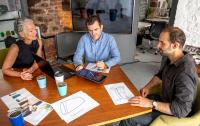 Add My Company
Add My Company
Sign In

DESIGN THINKING
WHAT IS THE DESIGN THINKING PROCESS?
The Design Thinking Process is a cognitive and practical series of actions that describes different phases of problem-solving. Based on developing a deeper understanding of human problems through a questioning approach, the Design Thinking Process attempts to find solutions by applying five broad principles:
Understanding needs
Defining the problem
Generating ideas
Prototype or formalising solutions
Testing concepts or ideas
These phases may be sequential but are frequently parallel, iterative or cyclical. In product design, this ‘hands-on thinking’ is particularly useful to understand and to find innovative and original solutions to problems that are complex, difficult to define or that we know little about. The process can often uncover new elements of a problem and generate fresh ideas as well as establishing if solutions are technically feasible and economically viable.
DESIGN THINKING IS ABOUT UNDERSTANDING A PROBLEM, CHALLENGING ASSUMPTIONS AND EXPLORING SOLUTIONS
In practice, the Design Thinking process is far from an abstract concept. At Flynn Product Design we use these techniques every day to push the boundaries of product development whether we’re collaborating with individuals, start-ups or bigger companies.
As design engineers, these processes inspire us to dig deeper to better understand the user, challenging existing norms and overturn conventional thinking. It’s a state of mind that’s about maximising opportunity and considering everything as improvable. And through collaboration and innovation, our objective is to create optimal solutions and emotional connections with real-life designs.
Here’s how the Design Thinking Process works.
Contact us Paper plane light sml
STAGES OF DESIGN THINKING
The stages of Design Thinking can be broadly separated into 5 stages:
Empathising and understanding human needs
Questioning and defining the problem
Challenging assumptions and generating ideas
Prototyping or formalising ideas and solutions
Testing and evaluating concepts or ideas
Let’s take a closer look at each phase of this design methodology and the role that each stage plays in informing, guiding and formulating solutions.
UNDERSTANDING NEEDS
Understanding the user is the starting point of the product designer’s quest for a fundamental need for knowledge.
It’s logical that identifying and understanding the target group and their experiences should also be the starting point of any human-centric product design project.
What problems do users face?
Are their problems particular or universal?
What are the consequences of their problems?
What are the current solutions?
By using a range of tools and methods, we question, research, study and observe the challenges of users in a particular situation and dig deeper into comprehending the nature of the problem.
Our overriding approach of empathy guides us to imagine an experience from another person’s point of view. And when we’ve identified the ‘pain-points’ and narrowed down the problem, we’re able to use the data and information to move a step closer towards a solution.
DEFINING THE PROBLEM
After fully understanding the needs of the user, the Design Thinking Process commonly features a clear definition of the problem. This is what’s commonly known as a Problem Statement.
It’s a frequent assumption that ‘we already know what the problem is’. But do we really?
A crucial aspect of Design Thinking is about asking questions.
The value of this stage is to actively question ‘the problem’, challenge assumptions and question the implications. Formulating a Problem Statement implicates having a clear thought-out identification of the actual problem – which may or may not be what we thought it was in the first place.
Once we’ve identified and defined the problem’, it guides us towards an objective to reach, based on the human needs of the user.
ThinkingCaps Industrial Designers
GENERATING IDEAS
Here’s the fun part.
Brainstorming. Thinking outside the box. Having a ‘light-bulb’ moment.
Call it what you will, there are no right or wrong answers, no good or bad ideas. This is where the Product Designer’s imagination and creativity run free.
At Flynn Product Design, ideas and concepts are often the fruit of collaboration, sharing ideas and being inspired by others. Using a range of creative processes we constructively challenge ideas and identify alternative and innovative solutions.
From the initial generation of ideas, our goal is then to develop the idea or group of ideas into a concept that holds the most promise or appears to be the best solution to the problem. This is the reason to progress to the prototype phase.
TOPL new Exploded
TOPL new Exploded
PROTOTYPING IDEAS
It’s time to make things happen.
The prototype is the tangible formulation of an idea or design. Whether it’s a sketch, mock-up or function model, the prototype is hands-on Design Thinking. The objective is again to answer questions about the idea:
Does it work?
What does it look and feel like?
What are the challenges in the materialisation of the idea?
This phase allows prototype designers to answer a raft of questions based on the functionality, ergonomics, and technicity of an idea, manufacturing technique or choice of materials.
It’s also a valuable opportunity to interact with a design from a human perspective.
Depending on the nature of the product design, the form, materials, colour, and texture of a design can be evaluated from an aesthetic or emotional point of view, when you see it and feel it. Read more on how to get a prototype made.
TESTING, TESTING…
The purpose of the prototype is to be able to put ideas to test in ‘real-life’ conditions.
Remember the Problem Statement?
Referring back to that the definition of a problem, we can use the prototype to assess to what extent the idea or design solves it. This proof of concept is frequently used as a benchmark to validate ideas (or not) from the prototype testing stage.
But Product Development rarely ends on the first completion of a Design Thinking process.
Testing prototypes gives feedback and reveals information on different levels that weren’t previously known or taken into account. These discoveries can take designers back to the drawing board and potentially allow us to:
Redefine the nature of the problem
Modify or improve upon existing designs
Generate and test new ideas
And that’s the reason why Design Thinking tends to be cyclic and iterative in nature. It’s easy to imagine that Product Design projects can sometimes be time-consuming and costly, particularly in anticipation of the manufacturing and commercial elements of a project
That’s why making use of the unique skills and experience of a Product Designer is frequently a far more efficient investment of resources when you’re looking to develop a product idea.
Concept Generation Product Designer
Concept Generation Product Designer
HELPING YOU PUT YOUR IDEAS INTO ACTION
Working through a Design Thinking Process can be challenging, and a product is only as good as its brief.
At Flynn Product Design, our Startups Workshops are custom-made to help you think about your designs and accompany you on your product development journey. Find out how our insight and experience make your ideas come to life.
LET’S TALK ABOUT YOUR PRODUCT DESIGN PROJECT TODAY. GET IN TOUCH BY SENDING US AN EMAIL OR SIMPLY CALL 0117 2306887
For more information on DESIGN THINKING – SHAPE PRODUCTS OF THE FUTURE (IN 5 STEPS) talk to Flynn Product Design
Enquire Now
More Design Blogs
List your company on FindTheNeedle.

